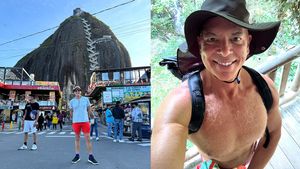You might not know his name, but if you've ever read a fashion magazine or watched a TV show or movie from the 1970s or '80s you've seen his work. David Frank Ray is a makeup artist and stylist to the stars who began his career in fashion, where he worked with magazines including Vogue and Cosmopolitan, and supermodels like Iman and Janice Dickinson.
Ray later moved to L.A. and took on some of the country's most celebrated celebrity clients like Jacyln Smith (Charlie's Angels), Sharon Stone (Basic Instinct) and Sigourney Weaver (Alien).
While he was teaching them makeup tips, Ray says he also learned a few things.
“Much of what we call beauty is genetic, of course,” Ray admits. But, he adds, “True beauty comes from self-love and self-confidence.”
As any America’s Next Top Model addict might guess, Ray says in the course of his career he’s met many young women who “had everything needed to be a model, except for these two qualities. By the same note, there have been plainer women that just seem to will themselves to be beautiful, with their confidence, charm, and intelligence. Their imperfections become the quality that makes them special.”
In the 1990s, Ray became creative director for Tova Borgnine's line of beauty products and Victoria's Secret's first cosmetics line. Then he moved into media, writing for MakeupBeat.com.
Beauty artists are often the unseen and unsung professionals essential to the fashion and entertainment industries — and to the air-brushed perfection of models, actors, and other celebrities. That was one reason Ray decided to create The Beauty Artists’ Hall of Fame, which formed in 2009 to honor industry stars like Max Factor.

(Ray, above with Jacyln Smith circa mid-1980s)
In addition, Ray says he wanted to “bring more of a community to the artists that work in the beauty industry. Also to help artists know the history of who came before and what they contributed to the world. I look forward to having a yearly event to celebrate and get to know each other better."
Never satisfied without giving back, Ray is determined to also use the event to raise money for causes"'that affect our industry, such as HIV/AIDS.”
Ray also founded and edits Irresistible Beauty magazine, an online fashion and beauty magazine for women over 50.
“The Baby Boomers are now in their 50s and they feel invisible — especially in today's media,” he notes. Ray hopes Irresistible Beauty will fill that void and help older women realize “they are beautiful no matter what age they are,” instead of listening to “our ageist and youth-obsessed culture that tells them they don't matter.”
Like the long term survivor himself, Ray’s target-audience is now “more experienced, they have more wisdom, they know who they are and what they want. My online magazine speaks directly to them, giving them beauty info and advice so they can make their own choices about what they like and want.”
To embrace the concept that beauty is more than skin deep, Irresistible Beauty also has a “Well Being" advisor who shares “different modalities to help our readers create peace in their body, mind and spirit. To be more relaxed, stronger and believe that they can do anything they put their mind to. Which adds to their inner beauty.”
Although Ray says, “I have my hands full working on Irresistible-Beauty.com,” he still finds time to volunteer with the Trevor Project. He calls the organization’s suicide prevention efforts among LGBTQ youth “so important. Depression can affect anyone and being able to talk to someone that understands can save lives.”
[Editor’s note: read about how depression compounds HIV and vice versa in our special report here.]
He volunteers at Trevor Project fundraisers “to help out any way that I can," Ray says. "Last time I helped celebs navigate the crowd and show them to their table. I also worked backstage to take care of the [emcee] during the event.”
Ray has won a coveted Clio award for his work in fashion ad campaigns, hobnobbed with celebrities, and founded his own business, magazine, and awards show. But, he says, none of those things hold a candle to a day three decades ago that still inspires.
“In the '80s, when HIV/AIDS was still pretty new, there was something called ‘The Healing Circle’ that met once a week.” Most of the hundreds of people who ended up attending the New York support group were living with HIV or were injection "drug users that were trying to quit,” Ray recalls. “It was an informal meeting — we all sat on the floor — and [it] gave people the space to share what they were going through. And at the end we would form a large circle and all say the word 'ohm' together. I'm most proud of the time I marched with our group in the gay Pride parade and handed out flyers of hope about AIDS to all the crowd. Then a very special thing happened when we all held hands, making our healing circle right in front of St. Patrick's Cathedral to say 'ohm.' It seemed like time stood still in that peaceful moment.”







































































